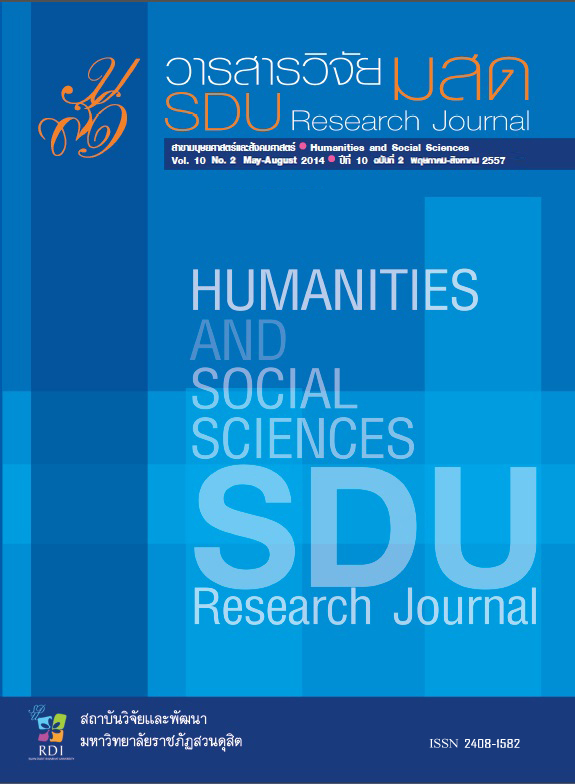การวิเคราะห์ต้นทุนและผลตอบแทนของการพัฒนาน้ำบาดาลเพื่อการเกษตรในพื้นที่การเกษตรแบบพึ่งพาน้ำฝน อำเภอหนองหญ้าไซ จังหวัดสุพรรณบุรี
Keywords:
การวิเคราะห์ต้นทุนและผลตอบแทน, การพัฒนาน้ำบาดาลเพื่อการเกษตรAbstract
บทคัดย่อ
การวิจัยครั้งนี้มีวัตถุประสงค์เพื่อวิเคราะห์ความคุ้มค่าทางเศรษฐศาสตร์ของการพัฒนาน้ำบาดาลเพื่อเป็นแหล่งน้ำเสริมสำหรับพื้นที่การเกษตรแบบพึ่งพาน้ำฝน ในอำเภอหนองหญ้าไซ จังหวัดสุพรรณบุรี โดยรวบรวมข้อมูลรูปแบบการปลูกพืช แล้ววิเคราะห์ต้นทุนและผลตอบแทนของการปลูกพืชแต่ละรูปแบบ เปรียบเทียบก่อนและหลังมีน้ำบาดาลเพื่อการเกษตร วิเคราะห์ความคุ้มค่าของการพัฒนาน้ำบาดาลเพื่อการเกษตรจากมูลค่าปัจจุบันสุทธิ (Net Present Value; NPV) อัตราส่วนของผลตอบแทนต่อต้นทุน (Benefit - Cost Ratio; B/C Ratio) อัตราผลตอบแทนภายในจากการลงทุน (Internal Rate of Return; IRR) และระยะคืนทุน โดยกำหนดให้การพัฒนาน้ำบาดาลเพื่อการเกษตรมีอายุโครงการ 10 ปี และมีการวิเคราะห์ความคุ้มค่าของโครงการใน 2 กรณี คือ กรณีที่ 1 หน่วยงานภาครัฐ คือ กรมทรัพยากรน้ำบาดาลเป็นผู้ลงทุนก่อสร้างระบบน้ำบาดาลเพื่อการเกษตร แล้วส่งมอบให้กลุ่มเกษตรกรเพื่อจัดการน้ำและใช้น้ำร่วมกัน และกรณีที่ 2 เกษตรกรเป็นผู้ลงทุนสร้างระบบน้ำบาดาลเพื่อการเกษตร สำหรับใช้ในพื้นที่ของตนเอง ผลการวิจัยพบว่ารูปแบบการปลูกพืชที่ให้ผลตอบแทนทางเศรษฐกิจคุ้มค่าที่สุด คือ การปลูกข้าวนาปี แล้วปลูกพืชผัก 2 ครั้ง ซึ่งในกรณีที่ 1 จะมีมูลค่าปัจจุบันสุทธิ (NPV) 314,466.88 บาทต่อไร่ อัตราส่วนของผลตอบแทนต่อต้นทุน (B/C Ratio) เท่ากับ 1.91 อัตราผลตอบแทนภายในจากการลงทุน (IRR) ร้อยละ 88.44 ระยะคืนทุน 1 ปี และในกรณีที่ 2 จะมีมูลค่าปัจจุบันสุทธิ (NPV) 257,212.21 บาทต่อไร่ อัตราส่วนของผลตอบแทนต่อต้นทุน (B/C Ratio) เท่ากับ 1.78 อัตราผลตอบแทนภายในจากการลงทุน (IRR) ร้อยละ 73.75 ระยะคืนทุน 1 ปี
คำสำคัญ : การวิเคราะห์ต้นทุนและผลตอบแทน การพัฒนาน้ำบาดาลเพื่อการเกษตร
Abstract
This research aims to analyze the economic performance of the groundwater development for supporting the rain-fed farm area in Nong Ya Sai District, Suphan Buri Province by collecting cropping pattern data. The cost – benefit analysis of each cropping pattern was needed to compare before and after developing groundwater for agriculture. The groundwater development for agricultural project is set up for 10 years. The analysis is divided into 2 cases:1) the government agency (the Department of Groundwater Resources) has constructed the groundwater for agricultural system, then let the group of farmers manage by themselves, and 2) a farmer has constructed the groundwater for agriculture system and use it on his own farm. The result has shown that the most economically feasible cropping pattern is in-season rice and 2 succeeding vegetable crops which are thereby produced a net present value (NPV) of 314,466.88 Baht per rai, the benefit-cost ratio (B/C Ratio) of 1.91, the internal rate of return (IRR) of 88.44% and the within one year payback period for the first case. The second case yields NPV of 257,212.21 Baht per rai, the B/C Ratio of 1.78, IRR of 73.75% and the within one year payback period.
Keywords: benefit-cost analysis, groundwater development for agriculture







